Old Papua New Guinea Abelam Carved Wooden Yam Peg / Stake Circa 1960s. (A)
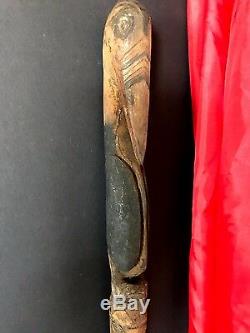
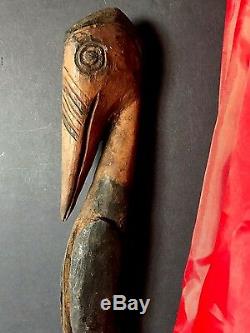
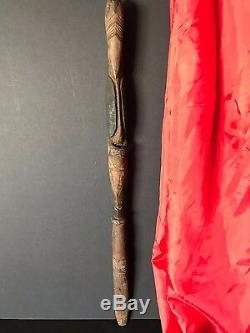
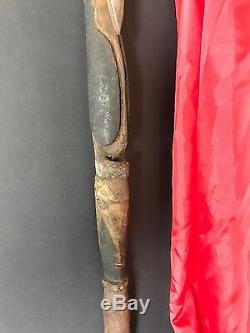
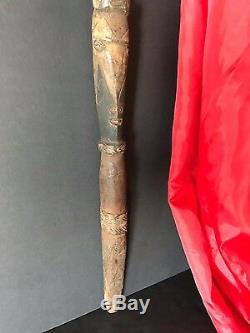
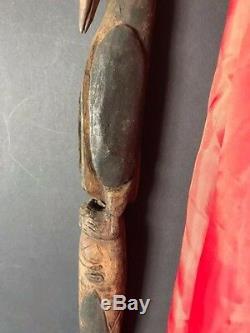
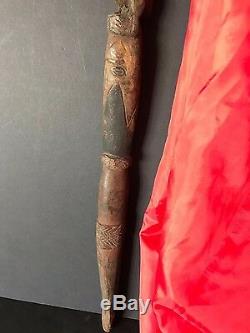
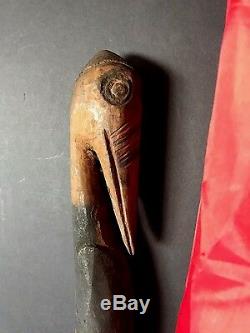
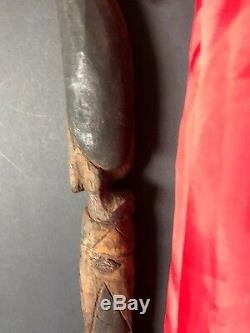
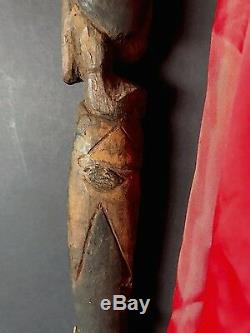
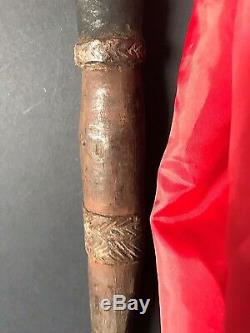
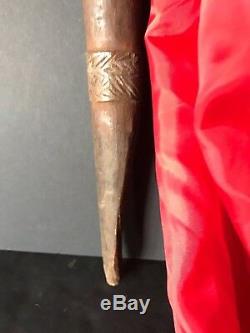

Old Papua New Guinea Abelam Carved Wooden Yam Peg / Stake. Circa 1960s collection piece (A).
Circa 1960s collection piece One of three being offered and listed separately. The Abelam are a people who live in the East Sepik province of Papua New Guinea. They are a farming society in which giant yams play a significant role. They live in the Prince Alexander mountains near the north coast of the island. Their language belongs to the Sepik family.
The Abelam live in the tropical rain forest and clear ground by burning. Their main food crops are yams, taro, bananas, and sweet potatoes. They supplement this with food gathered from the rain forest as well as pigs and chickens raised domestically. They also hunt small marsupials and cassowaries. Yam growing forms a large part of Abelam society. The growing of large yams they can be as large as 80-90 inches (2.3 m) long determines the status of individuals as well as the whole village.At yam festivals, an individual would give his largest yam to his worst enemy who would then be obligated to grow an even larger yam or have his status fall each year in which he was unable to do so. Separate villages would gather at yam festivals where the hosting villages status would be determined by the size of their yams as well as their ability to provide more food than could be eaten and carried away by the rival village.
During the yam growing season strong emotions were kept to a minimum as they were thought to impede the growth of the yams. Fighting was taboo as was sexual activity. It was thought that the yams had a spirit and could sense any of these strong emotions.Please see detail photos which form part of the description LNG/H. 65 cm Long X Approx. We cannot fix a problem we do not know about.
We strive for straight A+ and all 5s in our feedback and will bend over backwards to achieve this. I have many regular and happy customers and hope that you will also become one of them. Many of the items for sale at Jims International Bazaar were collected by Jim on his around the world adventures as an author, photojournalist and photographer. They include Turkish rugs, copper and brass, and artifacts from.
These things are from his privet collection, none were bought for the purpose of reselling but rather to decorate his home. Many new items will be listed as they are unpacked from storage along. With a wonderful collection of photographic prints including many wildlife photos and prints of tigers photographed in. Is an internationally renowned photojournalist and adventurer, with two major photographic books (New Guinea & Cannibal), plus covers and major spreads in a whole host of internationally prestigious magazines from Life International to The Geographic and Argosy.
He's been shipwrecked in the Pacific, wrestled camels in. And scoured the New Guinea Highlands in search of missing American heir and adventurer Michael Rockefeller. He has also lived and worked in the jungles of.
For over two years while collecting material for his books and records. A blue-water yachtsman, he sailed his own 60ft yacht, the "Moana Vahine", from Hong Kong to Southern Turkey, down the South China Sea, across the Indian Ocean, and up the full length of the Red Sea, via Singapore, Panang, Sri lanki, The Maldive Islands, and French Djibouti. An avid diver and spear fisherman, he mounted a series of diving expeditions in The. In addition to several years in. He has organized and/or participated in photographic expeditions in. And some of the more remote islands of the south pacific. "On board the forty-foot ketch, the "Marquesa, we were the first yacht to visit the remote. In the Marquesas in almost two years.The item "Old Papua New Guinea Abelam Carved Wooden Yam Peg / Stake Circa 1960s. (A)" is in sale since Wednesday, April 26, 2017. This item is in the category "Antiques\Ethnographic\Pacific Islands & Oceania".
The seller is "jimapix" and is located in Miranda, South Sydney, New South Wales. This item can be shipped worldwide.- Material: Wood
- Original/Reproduction: Original
- Provenance: Abelam are a people who live in the East Sepik pro
- Product Type: Yam / Sago Peg / Stake
- Originating Region: Papua New Guinea
- Era: 1960s

